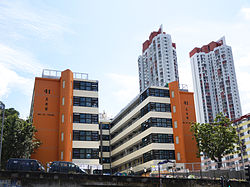Mei Ho House
| Mei Ho House 美荷樓 | |
|---|---|
 Mei Ho House in 2013, after renovation | |
 | |
| General information | |
| Location | Shek Kip Mei Estate, Sham Shui Po, Hong Kong |
| Coordinates | 22°20′02″N 114°09′49″E / 22.33395°N 114.163705°E |
| Opening | 24 October 2013 |
| Management | Hong Kong Youth Hostels Association |
| Affiliation | Hostelling International |
| Other information | |
| Number of rooms | 129 |
| Number of restaurants | 1 |
| Parking | No |
| Website | |
| www | |
| Mei Ho House | |||||||||||||
|---|---|---|---|---|---|---|---|---|---|---|---|---|---|
| Traditional Chinese | 美荷樓 | ||||||||||||
| Simplified Chinese | 美荷楼 | ||||||||||||
| Cantonese Yale | méih hòh làuh | ||||||||||||
| Literal meaning | beautiful lotus building | ||||||||||||
| |||||||||||||
Mei Ho House (Chinese: 美荷樓), formerly part of Shek Kip Mei Estate, Hong Kong, is the last remaining example of a "Mark I" building in a single-block configuration. While the other buildings of the estate dating from the 1950s have been demolished, being replaced by new ones, Mei Ho House was chosen to be preserved.
History[]

After a devastating fire in December 1953 that left thousands homeless, the Colonial government built a 29-block resettlement estate on the site of the burnt-down shanties to house the homeless victims.[1] Eight blocks (Blocks A to H), later renumbered as Blocks 10 through 13 and 35 through to 41, were constructed with the financial aid of the United Nations (Mei Ho House is Block H, later Block 41). These 7-storey blocks were constructed in the Bauhaus architectural style[2][3] with an 'H' configuration consisting of 2 residential wings, with communal sanitary facilities linking them.
During the Hong Kong 1956 riots, the building was used as one of the bases for the rioters.
Preservation[]


The building has been preserved as a record of Hong Kong's public housing development. It was listed as a Grade I historic building in 2005 and as a Grade II historic building in 2010.[4]
In 2008, it was part of the seven buildings of Batch I of the Hong Kong Government's Revitalising Historic Buildings Through Partnership Scheme.[5] On 17 February 2009, the government declared that the building would be used by the Hong Kong Youth Hostels Association as "City Hostel". The capital cost of the project was estimated at HK$192.3 million. Estimated completion time was 2012.[6] The hostel would also have an exhibition area with guided tour detailing the living environment of public housing units in the past.[7]
Opening[]
Mei Ho House Youth Hostel was open for business from Thursday, 24 October 2013. A dormitory room with four bunk beds costs from HK$260 per person. A double room costs from HK$680 per night while a family room costs from HK$1,320. At the opening, Chief Secretary for Administration Carrie Lam described it as a "pioneering renovation project" for a public housing estate and "very meaningful."[8]
Gallery[]

Mei Ho House in 2007
Mei Ho House in 2009

2009

2009

2009

2009

2009
Undergoing renovation in 2012
See also[]
- North Kowloon Magistracy, adaptive reuse of a nearby historical building
References[]
- ^ Choi, Barry (30 June 1975). "Housing means more than a roof" (PDF). South China Morning Post. Retrieved 7 February 2007.
- ^ https://www.bloomberg.com/news/features/2021-11-09/the-design-history-of-hong-kong-s-microflat-homes
- ^ https://www.wsj.com/articles/BL-SJB-13248[bare URL]
- ^ List of the Historic Buildings in Building Assessment Archived 22 September 2013 at the Wayback Machine
- ^ Conserve and Revitalise Hong Kong Heritage: Batch I of Revitalisation Scheme
- ^ Batch I of Revitalisation Scheme – Result of Selection – Mei Ho House as City Hostel
- ^ "Mei Ho House of Livelihood". Hong Kong Youth Hostels Association. Archived from the original on 25 April 2012. Retrieved 9 October 2011.
- ^ Qi Luo (22 October 2013). "Hostel brings new life to estate block". The Standard. Archived from the original on 23 October 2013.
External links[]
| Wikimedia Commons has media related to Mei Ho House. |
- YHA Mei Ho House Youth Hostel website
- Revitalising Historic Buildings Through Partnership Scheme: Mei Ho House Resource Kit
- Virtual tour of Mei Ho House
- Public housing estates in Hong Kong
- Shek Kip Mei
- Grade II historic buildings in Hong Kong
- Hostels
- Hotels in Hong Kong








